Menu
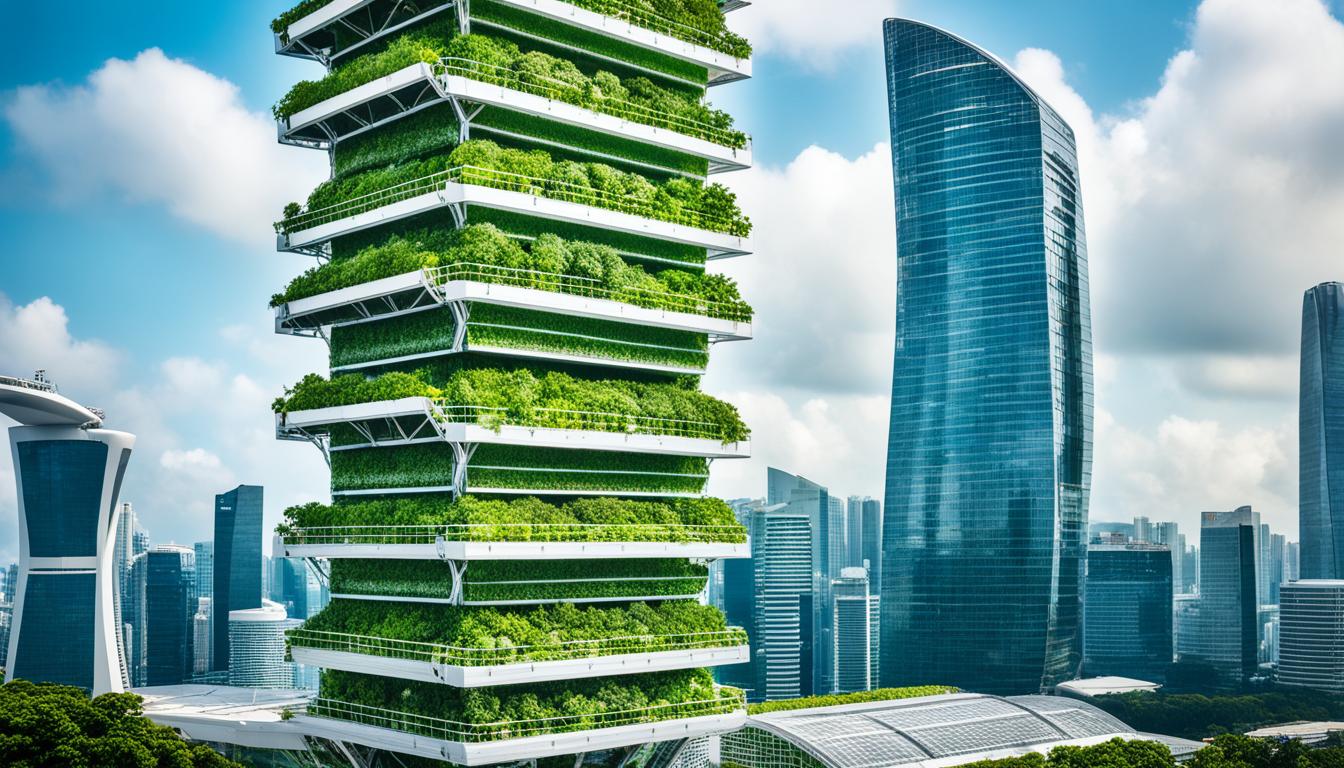
Did you know Singapore imports over 90% of its food? Despite having very little land for farming, and most people living in public housing, it faces big food security issues. Yet, it has turned this around. Singapore leads in sustainable food production through vertical farming Singapore case studies.
With indoor farming technology, innovative solutions are at work in Singapore. They are making the most of small spaces for farming. For example, Sky Greens uses rotating farms to *grow fresh produce*. The Plant Chicago shows how farming in the city can turn old industrial areas into green spaces, helping the economy and the environment.
This case study looks into how Singapore has embraced urban farming in a big way. It explores the new farming practices, their effect on food production, and how they can help other cities with similar problems.
Vertical farming is a new way to grow food in cities, where space is tight. This modern method stacks crops to make the most of limited land. It’s great for densely packed areas like Singapore.
Vertical farming means we grow crops up rather than out when the ground is scarce. It uses special indoor farming methods to create the perfect environment for plants. Things like hydroponics, aeroponics, and LED lights help plants grow well without using a lot of water and energy.
Green energy from things like solar panels and wind power also plays a big role. It all adds up to make farming in the city not just possible but sustainable.
Its main benefit is its efficiency. It can produce more food in less space than traditional farms. Being close to the city means fresher food and less waste from transporting it far. This matters a lot for the environment and for keeping food fresh.
Cities like Singapore face a big problem with growing their own food because they are so crowded. Most of their food is brought in. With little space and most people living in tower blocks, local food production is essential. Vertical farming steps in to help, improving food safety and keeping the city fed, especially when food supplies from outside may be disrupted.
It does more than just provide food. It helps fight urban heat and creates jobs for those who need them, both in the city and from the countryside. As more of us live in cities, vertical farming will play a bigger part in making sure we have enough food and a healthy planet.
Vertical farming minimises greenhouse gas emissions by reducing transportation distances between farms and urban centres, contributing significantly to sustainable urban living.
Many governments are starting to support vertical farming with money and tax breaks. They hope this will make cities greener and our food system better. Even though it needs a lot of money upfront, in the long run, it’s likely to do more good than harm.
| Traditional Farming | Vertical Farming |
|---|---|
| Requires large horizontal space | Maximises vertical space utilisation |
| High water and soil usage | Minimal water use and no soil |
| Dependent on weather | Controlled environment for optimal growth |
| Higher transportation emissions | Reduced transportation emissions |
The story of vertical farming is captivating. It’s full of big moments and big ideas. In the early 20th century, dreamers like Buckminster Fuller and M.C. Escher set the stage. Their early ideas became real in the 1990s. Vertical farming uses space wisely, using much less land than normal and helping to save trees.
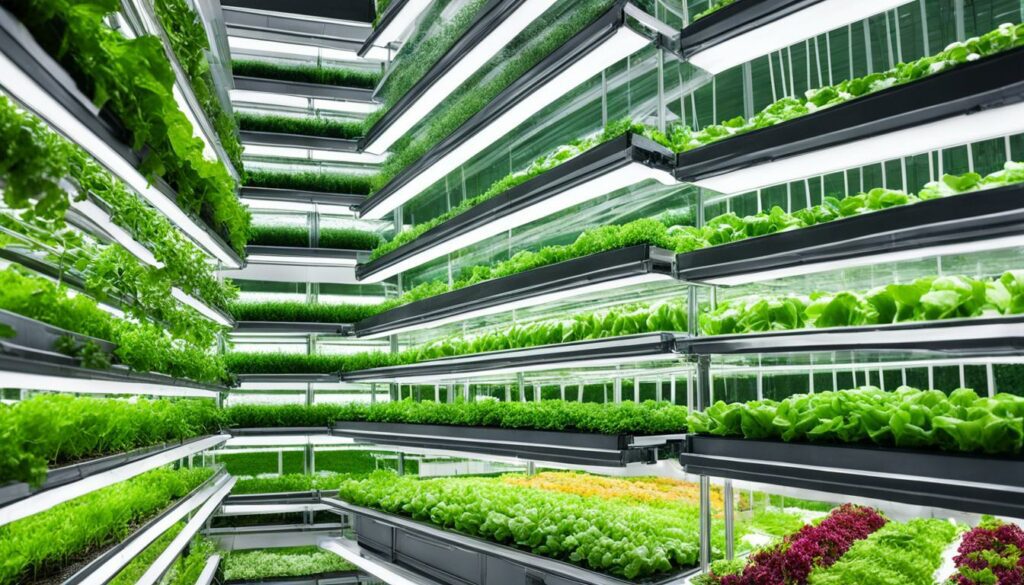
In the early days of vertical farming, Dickson Despommier was a key person. Around the early 2000s, his big idea shone a light on urban food problems. He suggested tall greenhouses as a fix. These farms grow food all year, no matter the season.
Schemes like AeroFarms have now made Despommier’s dream a reality. They show vertical farms can grow lots of food using fewer resources. Still, there are challenges. High costs and how to make it work for small farms are big issues.
Singapore is leading the way in making vertical farms work. They’re turning to this tech to deal with not much space and make food safer. A project called Sky Greens in Singapore uses a smart rotating system. It makes the most of small spaces, letting cities grow lots of their own food.
Here, the government really backs vertical farming. They help out with money and tax breaks. Their goal is to be greener and stronger. Singapore is always learning how to farm better in the city. This means they are staying ahead, even solving problems like using too much energy. New lights and power from the sun are helping to fix this.
Singapore’s work in vertical farming shows they care about the world. And they’re sharing what they learn with other cities looking to do the same.
Urban agriculture is changing fast, and tech in vertical farming is key. It helps deal with the challenges of more people needing food and the strain on food security. Innovations like hydroponics, aeroponics, LED lighting, and automation are making food production more efficient and earth-friendly in cities like Singapore.
Hydroponics and aeroponics are at the heart of vertical farming. They use no soil, growing plants in solutions full of nutrients. Hydroponics is working really well in Singapore, producing a lot with little water, beating old farming ways. Aeroponics grows plants in the air, spraying them with nutrients. This way, they grow quicker and stronger.
As more people live in ASEAN cities and space gets tight, these farming types are a great solution. They make it possible to grow good food in the city. Aeroponics, especially, fits in small urban areas, helping to make sure we have enough food.
Adding LED lights to farming is a game changer. These lights copy the sun’s natural light perfectly. It means crops can be grown indoors all year, no matter the weather.
Farming is getting smarter with automation too. Machines now handle the air, water, and food for plants. This cuts down on mistakes people might make.
All these new technology means farming is changing fast. It’s helping cities adapt to climate change and grow sustainably. Now, cities can use these tools to keep food coming, no matter what.
With less farmland and more pesticides, using advanced farm methods is crucial. Vertical farming is a way to make food in the city, without harming the planet. It’s a big part of reaching sustainable development goals worldwide.
Singapore is working hard to make sure it has enough food. It uses special farming in the city. Since most food is brought in and very little land is there to grow food, Singapore needs to think outside the box.
The abstract provides valuable insights into ongoing research efforts dedicated to food security in Singapore, shedding light on the multifaceted challenges faced and potential solutions explored.
One smart way Singapore is growing food is by going up, with vertical farming. This method is efficient and allows for year-round farming. Another cool way is aquaponics, a mix of fish and plant farming. These new methods help Singapore be ready in case it can’t get food from other countries.
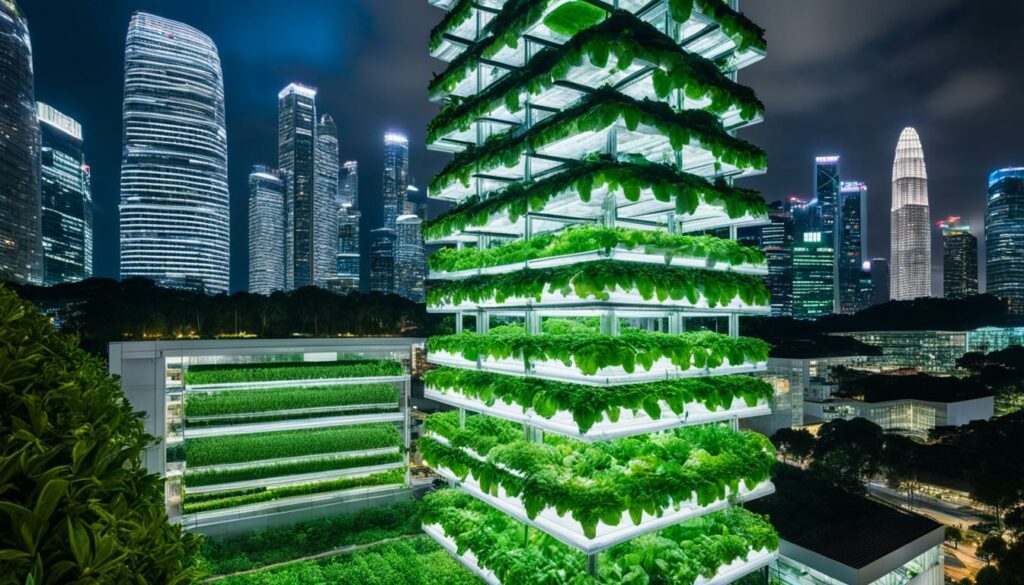
Urban farming in Singapore creates jobs for those living in the city or moving from the countryside. Since most people live in big apartment buildings, it’s important to have good ways to get the food to them. Because of climate change, the land for farming might decrease. This makes the city’s farming efforts even more important.
| Challenge | Solution |
|---|---|
| High dependency on food imports | Adopting controlled environment agriculture |
| Limited farmland | Implementing vertical farming techniques |
| Urban population density | Utilising HDB spaces for urban agriculture |
Singapore is leading the way in smart city farming. The city mixes farming with its city planning well. By using special farming and other new methods, Singapore is paving the way for other cities. It shows how to have plenty of food in crowded urban areas.
Vertical farming tackles the challenge of feeding cities sustainably. It uses space wisely and LED lights to grow more crops. This way, it cares for the environment by being efficient with resources.
Vertical farming needs less land because crops grow in stacked layers. This means it doesn’t use as much land as traditional farming. Also, it cuts down on greenhouse gas emissions by being closer to urban areas.
For example, The Plant Chicago is a great example. It reduces the distance between food sources and city dwellers. This decreases transportation pollution and secures urban food supplies.
It’s also great at saving resources. Places like AeroFarms in New Jersey produce lots of food with little waste. They use special systems that use less water and don’t need soil, saving the land.
Adding LED lights helps plants grow fast with less energy. This cuts costs and is good for the planet.
Plus, governments support these efforts with money and tax breaks. This encourages more farms to be sustainable. As cities keep growing, it’s key to protect our planet. Vertical farms help by providing local, fresh food in an eco-friendly way.
| Key Benefits | Traditional Farming | Vertical Farming |
|---|---|---|
| Land Utilisation | High | Low |
| Water Consumption | High | Minimal |
| Greenhouse Gas Emissions | High | Low |
| Energy Efficiency | Moderate | High |
In summary, vertical farming is a key solution for eco-friendly farming. It saves water, keeps our land healthy, and cuts down on emissions. By doing this, it helps make cities more productive while looking after the environment.
Singapore is a great example of how city farming is changing. It is using modern farming to make the most of its space. This journey started in the early 20th century with Dickson Despommier and his team at Columbia University.
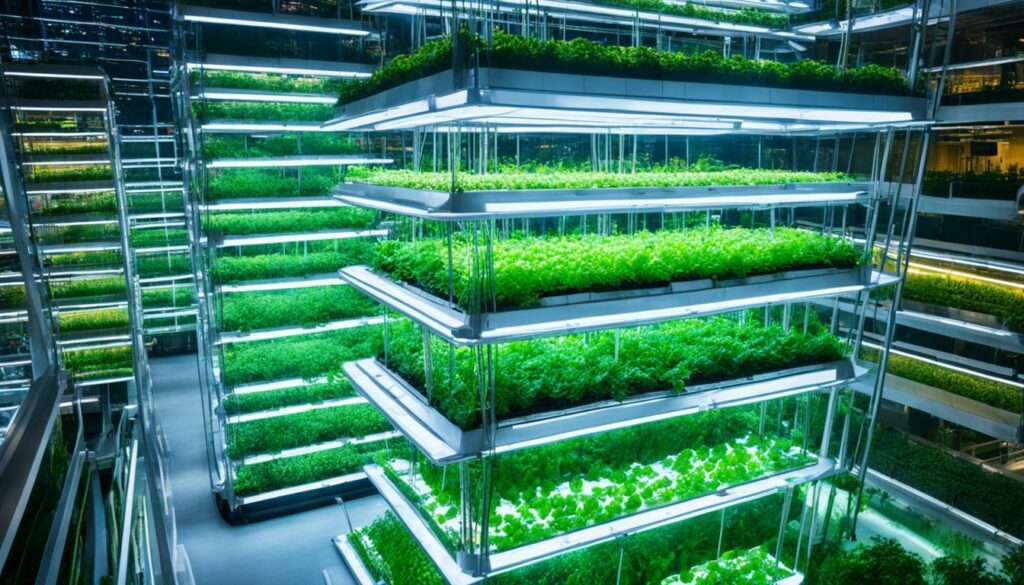
High-tech farms in Singapore help reduce harmful emissions. This is by cutting the long distance between farms and cities. It’s not just better for our planet. It means we get fresh food quicker, especially in places where it’s hard to find.
In Singapore, they use lots of cool technology. Automated systems check and control the farm’s conditions. LED lights are used to grow plants faster and save energy.
But vertical farming in Singapore also faces some challenges. It costs a lot to start, and it can be hard to grow the farms bigger. Some people worry about how much energy the lights use. Yet, they are working on solutions.
This farming allows crops to grow all year, making food supply stable.
Vertical farming in Singapore is not just good for food. It creates jobs and helps the economy. It shows how when governments, companies, and the public work together, farming can be both secure and earth-friendly. Singapore is a leader for other cities to follow.
They use advanced systems to grow food all year in the best way.
Below is a table comparing vertical farming with traditional methods:
| Feature | Vertical Farming | Traditional Farming |
|---|---|---|
| Land Utilisation | Maximises vertical space, requiring less land | Requires extensive land area |
| Environmental Impact | Reduces greenhouse gas emissions | Higher emissions due to transport and land use |
| Crop Output | Higher yields due to controlled environments | Variable yields dependent on climate |
| Energy Consumption | Optimised with LED lighting | Generally lower but less efficient growth rates |
| Investment Costs | Higher initial costs | Lower initial costs |
| Scalability | Scalability issues remain | Easier to scale horizontally |
Vertical farming case study analysis proves Singapore’s high-tech farms are smartly solving city farming problems
In our fast urbanising world, new farming ways are key to city growth. High-tech farming leads this change, finding new ways to feed city folk.
High-tech farms use the latest, like hydroponics, aeroponics, and LEDs. These methods stack plants, using little space. This is perfect for places like Singapore, with little land for food and huge imports. Sky Greens in Singapore show how tech makes farming better.
City farming also brings more fruits and veggies, happiness, and strong communities. With 68% of the world moving to cities by 2050, high-tech farms are crucial for food.
Blending urban planning and farming is vital. In crowded cities, we need smart plans to mix farming into our lives. This approach helps with local food and creates jobs for those in need.
City farming supports fairer economies and better food for everyone. It’s a great way to tackle space and climate issues. These urban farm ideas promise a strong, food-rich future.
In our fast-changing world, we need new ways to grow food. Controlled environments help by providing stable and predictable conditions. They let us grow food without relying on the weather or having a lot of land.
Controlled environments are perfect for plants. They get just the right amount of everything they need. Things like temperature, humidity, and light are carefully watched and adjusted. This way, plants can grow faster and better.
For example, urban vertical farming uses high-tech stuff like special lights and climate controls. These make sure plants grow well and use energy wisely. The outcome is more food produced, and it’s of top quality.

Vertical farming is also great for saving resources. It’s super efficient. This is really important in cities where there isn’t a lot of space or resources. It helps make farming more sustainable.
Imagine having fresh food all year, no matter the season. That’s what controlled environments can do. They make sure crops grow all the time. This helps places like Singapore not rely on food from far away. It also reduces pollution from transporting food.
They use cool methods like hydroponics and aeroponics. These ways save water and don’t need soil. Instead, they use special solutions for plants. This means we don’t have to use up all the good farming land. The result is more food with less environmental harm.
These new farming ways are changing how cities think about food. They are making food production better and safer. Thanks to places like Singapore trying these methods first, we now know they really work. It’s a big step towards feeding the world better.
Vertical farming brings big economic benefits. It creates new jobs and gives a boost to local economies. This method changes city spaces, making them more lively. It helps both the people and the businesses there.
Vertical farming is great for job opportunities. It needs various experts in urban areas:
Vertical farming boosts the local economy in a big way. It helps cities grow stronger and more diverse economically. This happens through:
All this shows how important economic benefits of vertical farming are. It makes cities tougher and more prosperous. That’s good news for everyone.
Vertical farming has many benefits. It uses space well and cuts down on harmful emissions. But there are hurdles on the way to more farms popping up.
Starting a vertical farm takes a big initial investment. You need technology like smart systems and LED lights. These are costly. Yet, they bring long-term benefits and help the farm run smoothly.
To overcome this, new ways of getting funds are key. Governments and investors can help by giving money or offering cheap loans. This makes starting a vertical farm easier, especially for smaller businesses.
But it’s not just about money. Making a vertical farm bigger can be hard. Even though many small ones are around, meeting the city’s growing food need is tough.
One approach is to use modular systems. These allow for slow, safe growth. Partnering with tech firms also helps. They can bring in better tools to run big farms well.
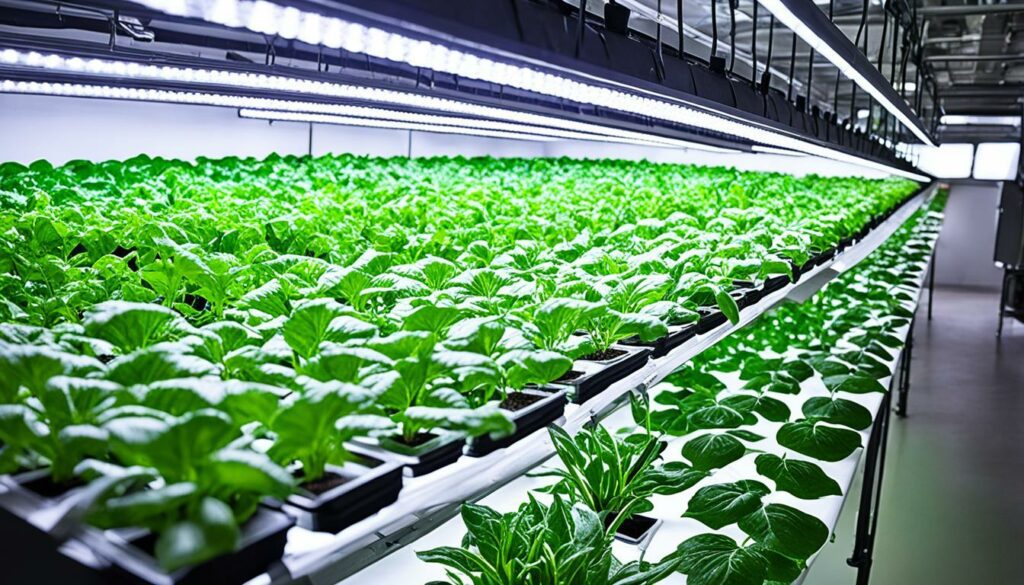
| Aspect | Challenge | Solution |
|---|---|---|
| Initial Investment | High financing required for setup | Subsidies, grants, low-interest loans |
| Scalability | Difficulty in expanding operations | Modular farming systems, advanced automation |
The outlook for vertical farming is bright. New tech is making it easier to grow. With the right funding and fresh ideas, vertical farming could lead to a big change in how we grow food.
With more people in the world every day, keeping everyone fed is a big worry. Vertical farming is changing the game. It lets us grow food in cities, making it easy and eco-friendly. Cities like Singapore use this to keep food coming without needing to rely on food from far away.
AeroFarms in New Jersey is a great example. They show us that we can grow a lot of food without using too many resources. This is good because it means we can always have enough food, even if the usual ways of getting it break down. Growing food indoors also means we can do it any time of the year. This makes sure there’s always something to eat.
In Singapore, a small island with not much space, Sky Greens is leading the way. They use smart systems and lights to grow a lot of food in a small area. This means they don’t need to bring in so much food from other places. Producing food at home helps Singapore rely less on others. It also helps the economy there.
World leaders are getting behind vertical farming, offering support to those who try it through money breaks and help. By making it part of how cities are planned, we can make sure we all have food without harming our planet. This way, our food system can be strong and able to bounce back from troubles.
Vertical farming started growing in the 1990s. Innovators, like Dickson Despommier from Columbia University, led the charge. It’s great for cities where there’s not much space. It’s important because cities need to use their land well. Governments are now supporting this kind of farming. There’s a lot of new research making vertical farming better.
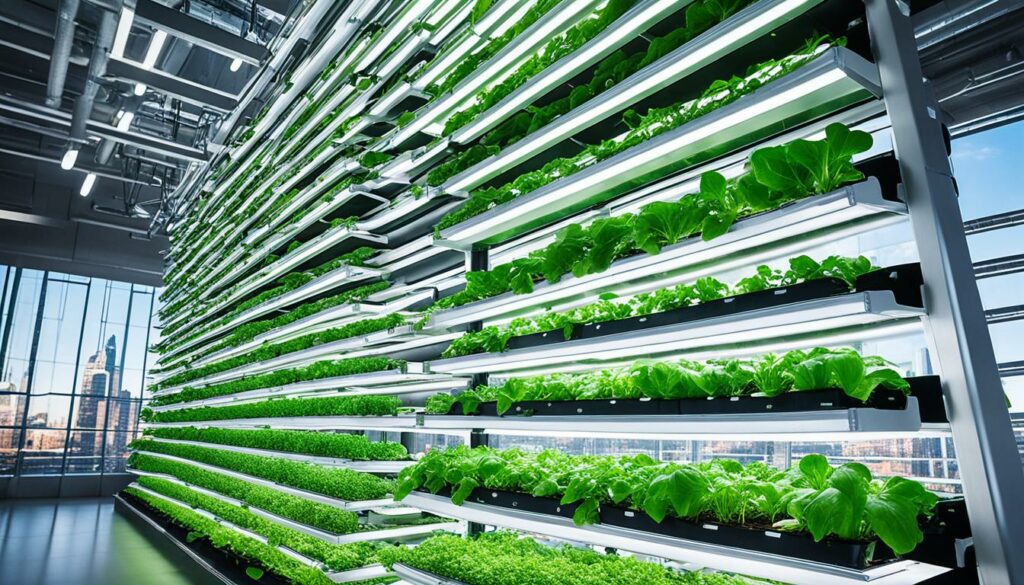
Countries are using policies to help vertical farming grow. This way of farming is getting popular because it helps feed crowded cities. Places like Singapore, with little land, are leading the way. They show how government help can make farming in the city work. By giving money and support, countries can have more vertical farms.
Scientists are finding new ways to make vertical farming work well. They’re looking for the best plants to grow and ways to use less water. Machines that watch the crops are also improving the harvest. LED lights and special soil-less growing methods are also key. They make it possible to grow food all year without hurting the planet.
Vertical farming is good for the economy too. It creates jobs for people who know how to run these farms. But, there are still big challenges like making it big, using less energy, and not hurting the planet. These are things that scientists are trying to solve.
Sky Greens in Singapore is a great example of using rotating vertical farms. This method helps use land well and increases farm yield. Despite limited urban space, they maintain sustainability through smart farming.
“Sky Greens in Singapore demonstrates innovative use of rotating systems in vertical farming, proving that even in a city with a population of 5 million inhabitants living in just 721.5 km², effective agricultural solutions are possible.”
Sky Greens shows how effective rotating vertical farm systems are. With its tall planting troughs, it can produce a lot in a small area. This method is ten times more efficient than usual farming.
It allows for daily harvests of vegetables with little energy and water use. The rotating design helps every plant get enough sun and nutrients. Sky Greens is not only productive but also eco-friendly.
Sky Greens’ system works great in the city, where land is scarce. It not only grows more food but does it without harmful chemicals. This improves the area’s environment.
Sky Greens Singapore is pioneering in solving food challenges in towns while caring for nature. It shows how vertical farms can use less space, be sustainable, and still grow lots of food.
Singapore leads in vertical farming, giving vital lessons for cities worldwide. The global impact of this farming method is huge, touching on food safety and resource use. With an upcoming population surge, following Singapore’s farming model is key.

Singapore shows how to use limited land very effectively. Its success with vertical farming highlights smart land use. This is crucial due to future land shortages and the need to grow more food with less space.
Comparing Singapore’s resource use gives important insights. Vertical farms are very efficient, saving water and energy. This is a critical lesson for crowded cities with limited resources.
Copying Singapore’s urban farming can change the world’s cities. Major cities like Seoul and New York also need space and food. By 2050, most people will live in cities. We need new farming solutions to meet this food demand.
Data and research back the benefits of vertical farming. 28% of findings were from books, 9% from conferences, and 15% from websites. More countries supporting this farming indicate a brighter future for global food safety.
At heart, replicating Singapore’s urban farming model offers great hope. It not only strengthens economies but also helps the environment. Following Singapore’s lead could mean a healthier, more sustainable future for all.
The outlook for vertical farming is very bright. Cities are getting bigger, and technology is moving forward fast. We may see 2.5 billion more people in cities by 2050. This makes a big need for new ways to grow food.
New technology plays a big role in the growth of vertical farming. Methods like hydroponics and LED lights help plants grow better. This means we can grow more food using less water and space.
How much electricity a farm needs depends on the type of crop. Lettuce needs less power than wheat. Using energy wisely and moving to solar power can make farms more eco-friendly.
Many countries are starting to see the benefits of vertical farming. Places like Korea, Japan, and the US are supporting it. A lot of research agrees that this type of farming is a good step for the future.
Growing food all year round and close to home is great for the planet. It cuts down on the gases that cause climate change. Policies and support from governments are key for the success of vertical farming.
Vertical farming is important as our cities get bigger. It could be the key to feeding everyone in the future. With the right technology and support, it can help solve our food needs.
The study of vertical farming, focused on Singapore, shows its key role. It boosts sustainable farming in cities and changes how we make our food. This method, started in the 1990s by Dickson Despommier and his students, addresses urban issues and food safety.
Looking at Singapore’s case, we see major advantages. For example, Sky Greens use a rotating system to grow crops efficiently. Also, AeroFarms shows we can grow a lot with less. This helps local businesses and makes us less reliant on food from far away.
Yet, there are hurdles to vertical farming’s success. It needs a lot of money upfront, faces scale issues, and uses a lot of energy. But, new energy-saving lights and help from the government with funding and tax breaks offer hope for a better agricultural future.
To sum up, vertical farming is a big leap for city farming that brings many good points. It’s key for a safer food supply. As we move forward, vertical farming’s chance to change how we grow food worldwide is clear. This future relies on everyone working together and being open to new ideas.
Vertical farming is growing crops in stacked layers. It uses many techs like hydroponics and aeroponics. This means crops can grow in the air without soil. Enhanced lighting is also used. It helps make the most of space, improves growth, and boosts how much is grown.
It’s vital for farming in cities. It lets us grow food near us. This, in turn, cuts costs of getting food to the city. It also helps keep food fresh and reduces the need for lots of space. So, it gets food to city people faster.
Dickson Despommier is key to spreading the word about vertical farming. He started talking about it in the early 2000s. He said it could change how we farm in cities, helping us all around the world. Not just at home, but everywhere.
In Singapore, they’re using the latest tech. Things like hydroponics and aeroponics, LED lights, and automatic climate controls. These are big reasons why they’ve done so well in a small space. They help make sure there’s enough food safely and without harm to the earth.
Key innovations in Singapore include hydroponics, aeroponics, LED lights, and sophisticated automation. These allow for efficient, clean, and climate-controlled growing of crops.
Urban farming, like vertical farming, makes Singapore less reliant on imported food. This means they have more stable and secure food supplies. It’s less affected by global food problems. Such as if far away places can’t send food.
Vertical farming is great for the environment. It uses less water, doesn’t ruin land, and lowers pollution. Plus, it helps wildlife in cities to thrive. All this is important to keep our earth healthy.
Farms like Sky Greens use advanced methods. They have rotating fields to grow more food. These innovative farms show how technology can feed more people in cities, even in a small space.
CEA fine-tunes growing conditions inside. It makes crops healthy and the same high quality all year. And, it doesn’t matter what the weather’s like outside. It keeps food supplies steady and reliable.
It creates jobs in tech, farming, and management. It boosts the local economy. Also, it brings new growth and stability to cities by starting new business.
High start-up costs and being able to grow big are challenges. To fix these, there are new ways to fund farms. Plus, technology is getting better and cheaper. All this makes vertical farming more doable for everyone.
By making a lot of food locally, places like Singapore don’t need to import as much. This makes them better at caring for themselves. Their food prices are also more steady. They’re less worried about not getting food from far away.
The government helps a lot with money, rules, and learning. It breaks down financial hurdles. It pushes new ideas and green ways of farming. It makes sure city folks have enough to eat.
They can learn about using high tech on farms, how cities are planned, and strong policies. Singapore shows how to overcome city limits. It’s about feeding its people without hurting the planet.
The future looks good with new tech and more cities doing it. More innovation, government help, and learning from places like Singapore will grow urban farming. This helps the whole world eat safely and in a way that’s good for the earth.